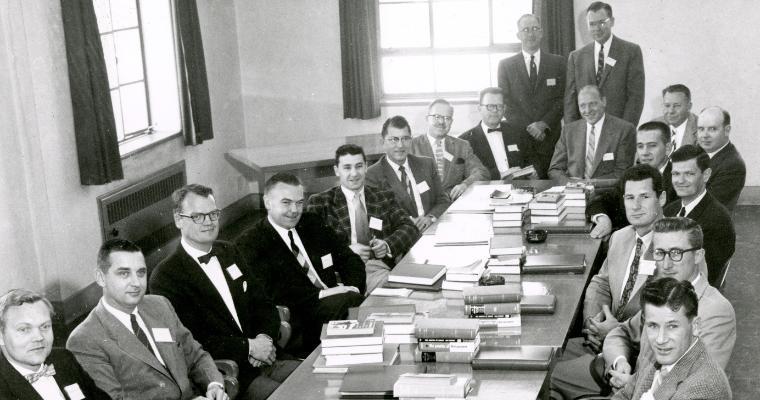
A Legacy of Innovation: Reset
Chapter 2: Reset (1941-1960)
Each month, Leavey News will feature a chapter from the centennial book "A Legacy of Innovation." Stay tuned for upcoming chapters.
Picture a verdant, palm-lined campus teeming with the trappings of college life. The shouts of students echo across green expanses of lawn. Groups of young men chatter excitedly about something they learned in class, or, more likely, about the social event they had just attended.
That scene felt increasingly distant in the early 1940s. Once-bustling open spaces at Santa Clara started to feel relatively empty. The decibel level indorms dropped drastically as young students became young soldiers and fought a war halfway around the world.
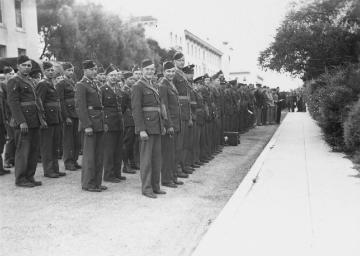
Charles Dirksen begins his 36-year tenure as dean. Students and faculty alike enlist and are drafted into World War II.
Charles Dirksen started his role as dean of the College of Business Administration — a position he would hold for a remarkable 36 years — just months before the attack on Pearl Harbor on Dec. 7, 1941. Like the students he was responsible for, he had no idea how much change was coming, and how swiftly.
War Disrupts Campus Life
The historian Gerald McKevitt described a sort of sheltered isolation on Santa Clara's campus in the 1930s. There might have been a protest here or there related to the social issues of the day, but for the most part, the outside world stayed just that: outside.
“World War II would shatter that isolation and break into a thousand pieces a pattern on campus life that could never be put back together again,” McKevitt wrote.
The drop in enrollment as the all-male student body enlisted was dramatic. Overall university enrollment had peaked in 1942 at 754. By 1945, it was 196. Seven men received degrees that year, with two of them from the business school. No degrees in business were awarded in 1944 or 1946. The BAA threw one of its many famed dances in 1943, but even that longstanding tradition was subsequently paused until the war ended.
Campus may have felt like a shadow of its earlier days, but there was still activity. California had asked all of its universities to develop crash-course training to support the war effort. Santa Clara’s focus at the time was in engineering training. However, the business school played its part, too, with industrial courses for members of the community offered at night. Classes included industrial cost accounting and office management. Faculty and administrators also offered seminars and symposiums for those who wanted to learn more about the industry of war.
Still, given the effects of lost tuition, the university’s and school’s coffers were soon as empty as its dorms. The College of Business Administration, which had been steadily expanding since its founding in 1923, found itself shrinking drastically for the first time in its existence — much like all schools and colleges at the time.
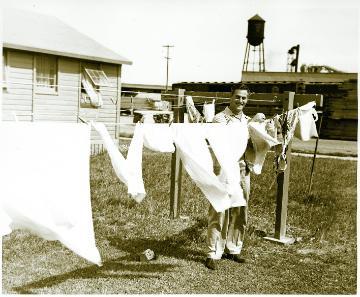
The university converted army barracks into a “veteran’s village” to meet housing demand.
The fix was on its way with the implementation of the GI Bill. After the war, a flood of students would hit campuses around the country, and Santa Clara was no exception. Fall 1946 saw a record-high 879 students. The university would crack 1,000 for the first time in 1947. That same year, 20 business degrees were awarded.
Demand outstripped supply, and an empty campus had an entirely new problem on its hands: crowding. Impromptu housing went up in buildings not originally intended for housing. Despite the crunch, the campus was fortunate to have experienced a building boom prior to the war, McKevitt said. Otherwise, crowding could have been significantly worse.
Having ridden through the lows and highs of war, Dirksen had his eyes on the future. The GI Bill brought a fresh wave of students, and it would take more expansive thinking to build on that wave.
The Comeback
Interestingly, one of Dirksen’s first postwar moves now seems a good 14 years ahead of its time — and a sign of firsts to come for the College of Business Administration. In 1947, he announced that women would be admitted to the school’s evening certificate program. Women wouldn’t be admitted as full-time undergraduates until 1961.
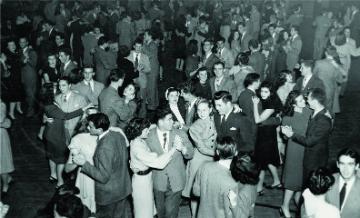
Campus was alive again as of 1946’s homecoming dance. In addition to this campus wide event, business students had a reputation for hosting major social events such as the Businessmen’s Blast dance.
Admittedly, that move might have had as much to do with generating fresh income as with any notions of equality at the time. But it was far from an isolated change, and it proved to be fiscally savvy. The night program pushed by Dirksen was popular and raised the school’s profile in the region. The businesses of Santa Clara County could send their employees to the school for training in modern business.
Still, perhaps the biggest change of the era was the “professionalization” of the faculty, said the historian George Giacomini. In this case, that meant hiring more faculty with doctorates and other terminal degrees and an increasing interest in research. That was like-wise a strategic move to raise the school’s profile — but nationally, not just regionally.
“After World War II, this idea of the teacher-scholar became more common,” Giacomini said.“It wasn’t enough just to be a good teacher. You had to be a good teacher, but you also needed to be doing research.”
University presidents William C.Gianera, S.J.; Herman J. Hauck, S.J.; and eventually Patrick A. Donohoe, S.J., all pushed for this professionalization.
Along with professionalization came another goal: accreditation. Accreditation is something the average student or faculty member might take for granted these days, but the university had struggled mightily to achieve it as a whole in 1932.
By the time Dirksen and the business school sought accreditation from the American Association of Collegiate Schools of Business(AACSB) in 1953, the path was much easier. The committee vote to allow the school membership was unanimous.
The Not-so-Quiet 1950s
George Giacomini himself graduated from Santa Clara in 1956. When he partnered with fellow historian Gerald McKevitt on a second volume of Santa Clara University history, titled Serving the Intellect, Touching the Heart, in 2000, he said the two men wanted to revisit some assumptions that no longer felt correct. One of those: That campus in the 1950s was mostly a staid, drowsy environment.
“The 50s were not quite as quiet as we thought,” Giacominisaid. “There were beat poets. There were protests of world events, like the Russian invasion of Hungary. We had our first women in graduate programs. Things like that sort of got lost to history when the 60s came along and brought a lot more change.”
The isolation of the 1930s was certainly gone. Despite many differences, the students of the 1950s focusing on social issues and experimenting with new personas have plenty in common with modern students. Russian invasions are still certainly a pre-dominant geopolitical event.
The not-so-quiet 1950s could well describe momentum at the business school, too. Those 20 degrees awarded in 1947 snow-balled to 85 by 1950. Despite some dips here and there in the 1950s, that number would mostly remain steady.
The growth was the result of strategy. Take the business school's much-lauded and highly awarded accounting program, for example. By 1950, its students were already accomplished enough to place fifth among 208 schools in the American Institute of Accountants Testing Program. A report that same year would rank the school’s accounting students as the best in the nation. Eight years later, a full 100 percent of its faculty held terminal degrees.
The idea that professionalization begets quality was taking hold and paying off. The increasing number of scholar-teachers among the faculty allowed the university as a whole to expand its graduate programs, with the College of Business Administration launching its MBA program in 1959. It earned accreditation from AACSB that very same year.
Even amid this forward progress, foundational principles remained. As Dirksen wrote in 1954 annual report, “Jesuit colleges have entered the field of collegiate business education because in our economy today it is essential to prepare men for private business and government who will possess sound judgment, high moral ideas, ability to evaluate critically, and who will have keen human understanding.”
For his part, Giacomini recalls some debate and controversy over shifting curriculum at the time: namely, whether or not everyone should still be required to take long-standing staples such as theology. “Still, everyone took philosophy, and of course, that included the students,” Giacomini said. “And that has remained constant.”
A Transforming Valley
Another important characteristic that has remained constant: connections with business in the region Santa Clara University calls home.
What started to change during the 1950s was the nature of those connections. There was always an economic impact on local business created by the campus’s mere presence. A 1951 economic study reported in the San Jose Mercury News tallied that economic impact in a headline: “SCU Supports Business Tune of $1,816,340.”
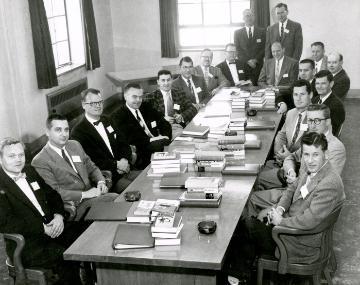
Management Center programs in the 1950s brought increasing numbers of executives from the region and beyond to the business school for special courses.
Local small businesses continued to send their bookkeepers and other employees to the night program for training, of course. The school started to get more actively involved in shaping the community in other ways, too. Dirksen and the College of Business Administration regularly sponsored conferences on the future of the Santa Clara Valley, particularly its industrial growth.
“The Santa Clara Valley was undergoing a radical transformation,” McKevitt wrote in his 1977 history. “Its population was expanding at an unprecedented rate, and fortunes were being made overnight as bulldozers swept its once fabled orchards into oblivion to make way for factories, freeways, and suburban housing.”
It was still the Valley of Heart’sDelight for the time being, but Silicon Valley was on the way. In turn, the region’s emerging corporations started to take more notice of the options available in the College of Business Administration. Eventually, that attention would lead to one of the nation’s first executive education programs.
These connections started small, with executive seminars in the early 1950s attended by leaders from the likes of Hewlett-Packard and Ford Motor Company. They picked up steam in the middle of the decade with multiweek courses attended by executives from HP, IBM, GeneralElectric, and other players in the emerging tech space. The Lockheed Corporation would eventually enroll large numbers of its employees in the MBA program, as well.
Increasingly, these companies started sending representatives to campus for career recruiting and speaker series, too. The benefit students gained from these added connections was clear: more insights, more networking, and more job placements.
By 1957, those less formal management development programs, conferences, and seminars evolved into the full-fledged Management Center. Just as the region’s tech-minded businesses would eventually form the core of what became Silicon Valley, this Management Center was the early form of the Leavey School of Business’ Silicon Valley Executive Center.
In some ways, this was a natural evolution, Giacomini said. But it also came to pass through outreach and intentionality. “Students had always come from mover-and-shaker families in the old valley,” he said. “There was always that connection to business. But things really opened up in the late ’50. By the 1960s, the university was going to get really involved in the new valley.”
